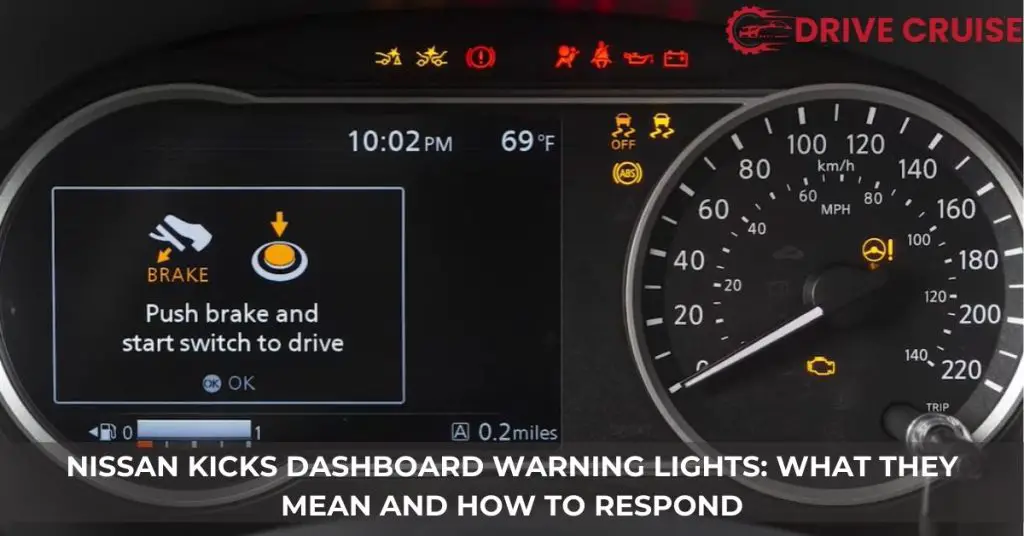Navigating the dashboard warning lights on your Nissan Kicks can sometimes feel like deciphering an ancient script. Each symbol, with its unique color and design, holds the key to understanding your vehicle’s health and safety status. We’ve all been there – driving along when suddenly a mysterious icon lights up, prompting a flurry of questions. What does it mean? Is it urgent? Can I fix it myself?
That’s where we come in. We’re here to guide you through the maze of Nissan Kicks dashboard warning lights, breaking down what each symbol signifies and how you should respond. From the critical alerts that demand immediate attention to the more informational ones that simply keep you informed, we’ve got you covered. Let’s demystify these luminous messengers together, ensuring your driving experience remains safe, informed, and, above all, enjoyable.
Understanding Nissan Kicks Dashboard Warning Lights
Recognizing the significance of dashboard warning lights in our Nissan Kicks is paramount for maintaining the vehicle’s health and ensuring our safety on the road. Each light on the dashboard serves as a crucial alert mechanism, indicating various conditions of our vehicle, from general maintenance needs to potentially severe issues. Let’s walk through some common types of warning lights we might encounter and how we understand their meanings.
- Engine Warning Light: This light appears as an engine icon and illuminates in yellow or red. If it’s yellow, it suggests a minor issue that requires attention soon. However, a red light indicates a more serious problem that needs immediate attention. It’s essential to diagnose the issue promptly to prevent further damage.
- Tire Pressure Warning Light: Shown as an exclamation point inside a tire shape, this light warns us of low tire pressure in one or more tires. Maintaining the correct tire pressure is crucial for our vehicle’s performance and our safety.
- Battery Charge Warning Light: The appearance of a battery icon on our dashboard signifies issues with the vehicle’s charging system. It might indicate a failing battery or problems with the alternator. Ignoring this light could result in our vehicle not starting.
- Oil Pressure Warning Light: Represented by an oil can icon, this light alerts us to low oil pressure in the engine. Immediate action is required to check the oil level and pressure to avoid engine damage.
- ABS Warning Light: The Anti-lock Braking System (ABS) light, indicated by the letters ABS, warns us of issues with the anti-lock braking system. While the car’s brakes will still function, the ABS may not operate in emergency braking situations, altering our stopping capabilities.
Understanding these dashboard warning lights in our Nissan Kicks not only helps us address issues before they escalate but also enhances our driving experience, ensuring we enjoy a safe journey every time we hit the road.
Identifying Nissan Kicks Specific Warning Lights
Building on our explanation of common dashboard warning lights, we’ll now delve into some Nissan Kicks-specific warning lights that are crucial for maintaining the vehicle’s performance and ensuring safety. Recognizing these lights and understanding their meanings empowers us to take timely action to address issues that may arise during our drives.
- Intelligent Key System Light: If this light stays lit or flashes after starting the engine, it indicates a malfunction in the Intelligent Key system. Checking the key battery and ensuring it’s within range is a good first step.
- Power Steering Warning Light: A light symbolizing a steering wheel next to an exclamation mark serves as a warning that there could be an issue with the power steering system. It’s important to have this checked by a professional to avoid steering difficulties.
- Forward Emergency Braking (FEB) Warning Light: Shown as a car with collision lines, this warns us of a malfunction in the Forward Emergency Braking system. Keeping this system functional is key to preventing accidents.
- Tire Maintenance Warning Light: Unlike the Tire Pressure Warning Light, this symbol suggests that the tires need inspection due to wear or damage, or it could simply be time for a rotation. Regular checks can prevent further tire issues.
- Chassis Control Warning Light: This light indicates a problem with the vehicle’s stability control system. When lit, it’s crucial to have the vehicle inspected to ensure optimal driving conditions.
Recognizing these Nissan Kicks-specific warning lights allows us to address potential issues before they become serious problems. By staying informed and proactive, we can maintain our vehicle’s health and ensure a safer, smoother driving experience.
What to Do When a Warning Light Comes On
Recognizing the significant impact that understanding Nissan Kicks dashboard warning lights has on vehicle maintenance and safety, we’re moving on to what steps to take when one of these lights illuminates. Once a warning light appears, identifying the problem and responding appropriately is crucial.
Immediate Actions
For lights that indicate serious issues, such as the Engine or Oil Pressure warning lights, immediate action is necessary. Here’s what to do:
- Engine Warning Light: If this light comes on, it’s critical to check for symptoms of engine distress, such as unusual noises or smoke. Pull over safely and turn off the engine. Consult your Nissan manual and contact a professional mechanic for advice.
- Oil Pressure Light: This light signifies low oil pressure. Immediately stop driving, turn off the engine, and check the oil level. If low, add the recommended type of oil. If the light remains on, it indicates a deeper issue; professional assistance is required.
Investigate Further
Some lights suggest that a problem may be developing or an important reminder:
- Tire Pressure Light: This indicates that one or more tires are significantly under- or over-inflated. Check tire pressures and adjust them according to the specifications found in your Nissan manual.
- Tire Maintenance Light: Often confused with the Tire Pressure light, this signifies that your tires need rotation or inspection. Scheduling a maintenance check is advisable.
- Forward Emergency Braking (FEB) Light: This light warns of a malfunction in the FEB system, a critical safety feature. Although not always an immediate hazard, get this checked promptly to ensure your vehicle’s safety features are fully operational.
Non-Urgent Warnings
For non-urgent warnings, such as the Intelligent Key System or Chassis Control lights, it’s generally safe to continue driving to a service location but address the issue soon:
- Intelligent Key System Light: This may indicate a malfunction with the key fob. Replacing the battery might resolve the issue, but if the light persists, professional diagnostics are needed.
- Chassis Control Light: This light suggests a minor fault with the vehicle’s stability control systems. Though not urgent, getting it checked ensures optimal vehicle performance and safety.
Maintenance Tips to Prevent Warning Lights
After exploring the intricacies of Nissan Kicks dashboard warning lights and learning how to respond when they illuminate, let’s dive into preventative measures. Keeping these warning lights at bay not only extends the life of your vehicle but also enhances safety and performance. Here are essential tips that help prevent these lights from turning on unnecessarily.
Regular Maintenance Schedules
Adhering to Nissan’s recommended maintenance schedule is critical. Routine checks include oil changes, tire rotations, and brake inspections. These services ensure systems remain in optimal condition, which, in turn, prevents warning lights related to engine, tire pressure, and brake systems from activating.
Tire Pressure Checks
Maintaining correct tire pressure is vital for safety, fuel efficiency, and the longevity of your tires. The Tire Pressure Monitoring System (TPMS) light activates when pressure is too low or too high. Check your tire pressure monthly and before long trips to avoid this warning light.
Battery Care
The Battery Charge warning light indicates issues with the charging system, often due to a failing battery or alternator. Regularly inspect your battery’s terminals for corrosion and ensure the battery is securely mounted. Consider having your battery tested annually, especially before cold seasons, to ensure it’s in good working condition.
Fluid Levels and Quality
Engine oil, coolant, brake fluid, and transmission fluid are crucial for your vehicle’s performance. Low or dirty fluids can trigger warning lights. Check fluid levels monthly and refill or replace as needed based on Nissan’s guidelines.
Immediate Light Response
When a light does turn on, addressing it promptly can prevent additional damage. For example, if the Engine Warning light activates, getting a diagnostic check can preempt more serious issues.
By following these tips, we not only minimize the risk of seeing these warning lights but also contribute to our Nissan Kicks’ longevity and reliability. Regular maintenance and prompt attention to issues enhance driving safety and vehicle performance, ensuring a smoother and more enjoyable driving experience.
How to Reset Nissan Kicks Dashboard Warning Lights
Resetting Nissan Kicks dashboard warning lights might seem daunting, but it’s often a straightforward process that drivers can accomplish with a few steps. Here, we’ll guide you through the typical methods to reset these warning lights, ensuring you can maintain your vehicle’s performance and safety.
Turn Off and Restart the Engine
First, try the simplest solution. Turn off your Nissan Kicks and wait a few seconds before restarting the engine. This action can, at times, reset warning lights if the issue that triggered them is no longer present.
Use the On-Board Diagnostics (OBD) Port
- Locate the OBD Port: Typically found underneath the dashboard, near the steering wheel.
- Connect an OBD II Scanner: This device can read and clear codes from your vehicle’s computer system.
- Follow the Scanner’s Instructions: Clear the codes related to the dashboard warning lights.
Check for Loose Connections
At times, a loose cable or connector, especially around the battery or engine sensors, can trigger warning lights. Inspecting and securing these connections might resolve the issue without the need for a reset.
Manual Reset Procedure
Some Nissan Kicks models allow for a manual reset of specific warning lights through a series of pedal presses and ignition turns. Refer to your vehicle’s manual for precise steps, as the procedure can vary based on the model year.
Visit a Professional
If the warning lights persist, it’s crucial to consult with a professional technician. They can diagnose underlying issues that aren’t apparent to the average driver. Ignoring warning lights can lead to more significant problems, including safety risks and costly repairs.
By following these steps, you can effectively reset your Nissan Kicks dashboard warning lights, or at least identify when professional help is necessary. Remember, these lights are crucial indicators of your vehicle’s health, and addressing them promptly ensures your Kicks remains safe and reliable on the road.
Conclusion
We’ve walked through the critical steps to understand and manage the dashboard warning lights on your Nissan Kicks. Remember, these lights are your car’s way of communicating its health and safety status. By keeping up with regular maintenance and addressing warning lights promptly, you’re not just ensuring a smoother drive but also safeguarding against potential hazards. And if you ever find yourself puzzled by a persistent light, don’t hesitate to reach out to a professional. After all, it’s always better to be safe than sorry. Let’s keep our Nissan Kicks running smoothly and safely, one warning light at a time.
Related Posts:













